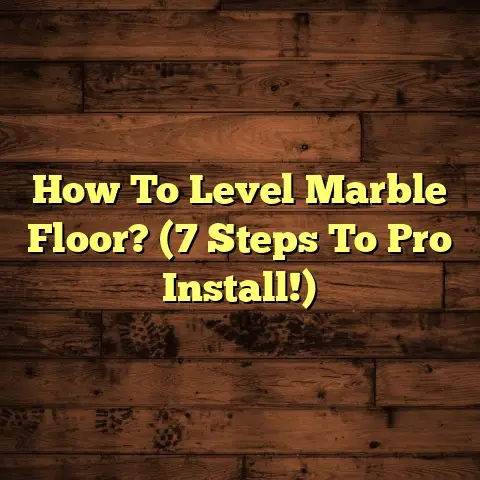Floating Floor Creaking? (3 Fixes You Must Know!)
Isn’t it great how floating floors have taken
over?
I mean, seriously, they’re so easy to
care for and maintain, plus they look fantastic
in just about any room.
I’ve installed tons of them over the years, and they’ve become a super popular choice for folks looking for a stylish and easy flooring option.
But let’s be real, sometimes those beautiful floating floors start to… well, creak.
It’s like living in a haunted house, but instead of ghosts, it’s just your floor announcing your every move!
Creaking is a common problem, and I’ve had
countless clients ask me about it.
The good
news is, it’s usually fixable!
In this article, I’m going to walk you through three effective solutions for tackling that annoying creak.
Trust me, with a little know-how, you can
restore peace and quiet to your home.
Let’s
dive in!
Section 1: Understanding the Cause of Creaking
Okay, so before we start grabbing tools and getting our hands dirty, let’s understand why your floating floor is staging its own personal symphony of creaks.
Subsection 1.1: What are Floating Floors?
First things first, what exactly is a floating floor?
Basically, it’s a flooring system that doesn’t
get nailed or glued directly to the subfloor.
Instead, the planks or tiles interlock, creating
a single, continuous surface that “floats” above
the subfloor.
Think of it like a giant puzzle!
Construction:
Floating floors typically consist of several layers:
- Wear Layer: This is the top layer, the one you walk on. It’s designed to be durable and resist scratches and stains. Materials vary, like laminate, vinyl, or even wood veneers.
- Design Layer: This layer provides the aesthetic appeal, mimicking the look of wood, stone, or tile.
- Core Layer: The core is the heart of the floating floor, providing stability and resistance to moisture. Common materials include High-Density Fiberboard (HDF) or Wood-Plastic Composite (WPC).
- Backing Layer: This bottom layer provides support and helps to protect the core from moisture.
How They Differ:
Unlike traditional hardwood floors that are nailed down, or tile floors that are mortared in place, floating floors are… well, floating!
This installation method is faster and often cheaper, making it a popular choice for DIYers and budget-conscious homeowners.
Subsection 1.2: Why Do Floating Floors Creak?
Alright, let’s get to the root of the problem:
why the creak?
There are a few common culprits:
Insufficient Expansion Space: This is probably the biggest offender. Floating floors expand and contract with changes in temperature and humidity. If there isn’t enough space around the edges of the room (typically hidden by baseboards or trim), the floor can bind against the walls, leading to creaking. Imagine trying to fit a puzzle piece into a space that’s too small – something’s gotta give!
Think of it like your skin in the winter – it gets dry and tight!
* Improper Installation: A poorly installedfloor is a recipe for creaking. Gaps between planks, uneven subfloors, or failing to follow the manufacturer’s instructions can all lead to problems. I’ve seen some interesting DIY installations over the years, let me tell you!
* Humidity and Temperature Changes: As I mentioned earlier, floating floors are sensitive to environmental changes. High humidity can cause the floor to expand, while low humidity can cause it to contract. This movement can lead to friction between planks, resulting in creaking.
A solid foundation is key for any successful flooring project!
* Subfloor Condition: The subfloor is the foundation upon which your floating floor rests. If the subfloor is uneven, damaged, or not properly prepared, it can cause the floating floor to flex and creak.
Here’s a quick table summarizing the causes:
Subsection 1.3: Identifying Creaking Areas
Okay, so you know why your floor is creaking,
but where is it creaking?
Pinpointing the
source of the noise is crucial for effective
repairs.
Here’s how to become a creak detective:
- Walk the Walk: Slowly walk around the room, paying close attention to where the creaks are coming from. Try to isolate specific areas or planks.
- Apply Pressure: Gently press down on different areas of the floor. Does the creaking get worse? Does it only happen when you step on a specific spot?
- Listen Closely: Sometimes, the creak isn’t directly under your feet. It could be coming from a nearby wall or doorway.
- Consider the Season: Does the creaking worsen during certain times of the year? This could indicate humidity-related issues.
Pro Tip: Enlist a friend or family member to
help!
One person can walk around and make the
noise, while the other person can listen and
pinpoint the source.
Once you’ve identified the creaking areas, mark
them with painter’s tape.
This will help you
stay focused when you start making repairs.
Section 2: Fix #1: Increasing Expansion Gaps
Alright, let’s get to our first fix!
As I
mentioned earlier, insufficient expansion space is
a major cause of creaking in floating floors.
Subsection 2.1: The Importance of Expansion Gaps
So, what exactly are expansion gaps, and why are they so important?
Expansion gaps are small spaces (typically ¼ to
⅜ inch) left around the perimeter of the room
during installation.
These gaps allow the floor
to expand and contract without putting pressure on
the walls.
Without these gaps, the floor can bind against the walls, leading to creaking, buckling, or even damage to the flooring itself.
Think of it like a bridge – bridges have expansion
joints to accommodate changes in temperature.
Your floating floor needs the same freedom to
move!
Subsection 2.2: How to Check Expansion Gaps
Okay, let’s see if your expansion gaps are up to
snuff.
Here’s how to check:
- Locate the Perimeter: Start by examining the edges of the room where the flooring meets the walls.
- Remove Baseboards (If Necessary): Carefully remove the baseboards or trim along the wall. You can usually do this with a pry bar and a hammer. Be gentle to avoid damaging the wall or the trim.
- Inspect the Gap: Once the baseboard is removed, you should be able to see the expansion gap. Is there a gap at all? Is it consistent around the entire perimeter?
- Measure the Gap: Use a ruler or measuring tape to measure the width of the gap. It should be at least ¼ inch, and preferably closer to ⅜ inch.
Warning: If you don’t feel comfortable
removing baseboards, you can try to peek behind
them with a thin ruler or feel for a gap with
your fingers.
However, removing the baseboards
will give you the most accurate assessment.
Subsection 2.3: How to Correct Expansion Gaps
- Remove Baseboards: As mentioned earlier, carefully remove the baseboards or trim along the wall.
Create Space: If there’s no gap, you’ll need to create one. You can use a saw (a jigsaw or circular saw works well) to trim the edges of the flooring. Be careful not to cut into the wall!
Safety First: Always wear safety glasses and a dust mask when cutting flooring.
3. Maintain Consistent Gap: Make sure the gap is consistent around the entire perimeter of the room.
4. Reinstall Baseboards: Once you’ve created the necessary expansion space, reinstall the baseboards or trim. You may need to use a nail gun or construction adhesive to secure them.
Important: When reinstalling the baseboards,
don’t nail them into the flooring!
You want the
flooring to be able to move freely underneath the
baseboards.
Nail the baseboards to the wall studs
only.
Personal Story: I once had a client who had
completely skipped the expansion gaps during their
DIY installation.
The floor was so tightly
wedged against the walls that it was buckling in
the middle of the room!
After creating proper
expansion gaps, the buckling disappeared, and the
creaking was gone.
It was like magic!
Section 3: Fix #2: Securing Loose Boards
Okay, let’s move on to our second fix: securing
loose boards.
Sometimes, creaking is caused by
individual planks that are not properly locked
together or have come loose from the subfloor.
Subsection 3.1: Identifying Loose Boards
How do you know if you have loose boards? Here are some telltale signs:
- Visible Movement: Can you see the board moving up and down when you step on it?
- Excessive Noise: Is the creaking particularly loud or noticeable in a specific area?
- Gaps Between Planks: Are there visible gaps between the planks in the area where the creaking is occurring?
- Feeling of “Give”: Does the floor feel soft or spongy in a particular spot?
If you answered “yes” to any of these questions, you likely have loose boards that need to be addressed.
Subsection 3.2: Tools and Materials Needed
Before you start fixing those loose boards, gather your supplies. Here’s what you’ll need:
- Floor Repair Kit: Many flooring manufacturers sell repair kits specifically designed for their products. These kits typically include adhesive, filler, and touch-up markers.
- Construction Adhesive: If you don’t have a repair kit, you can use a high-quality construction adhesive. Make sure it’s compatible with your flooring material.
- Screws (Optional): In some cases, you may need to use screws to secure the boards to the subfloor. Choose screws that are the correct length and type for your flooring and subfloor.
- Drill (If Using Screws): You’ll need a drill to install the screws.
- Caulk Gun (For Adhesive): A caulk gun will make it easier to apply the adhesive.
- Putty Knife: A putty knife is useful for spreading adhesive and filling gaps.
- Hammer and Tapping Block: These tools can help you gently tap the boards back into place.
- Safety Glasses and Gloves: Always protect your eyes and hands when working with tools and materials.
Subsection 3.3: Step-by-Step Fix for Loose Boards
Alright, let’s get those loose boards secured! Here’s a step-by-step guide:
- Clean the Area: Thoroughly clean the area around the loose board. Remove any dirt, dust, or debris.
Apply Adhesive (If Necessary): If the board is loose because the interlocking mechanism has failed, apply a small amount of construction adhesive to the edges of the board. Caution: Be careful not to use too much adhesive, as it can squeeze out and make a mess.
Important: Be careful not to overtighten the screws, as this can damage the flooring.
3. Tap the Board into Place: Use a hammer and tapping block to gently tap the board back into place. Make sure it’s flush with the surrounding boards.
4. Secure with Screws (If Applicable): If the board is significantly loose, you may need to secure it to the subfloor with screws.
Drill pilot holes through the board and into the subfloor, then install the screws.
5. Fill Gaps (If Necessary): If there are any gaps between the boards, fill them with flooring filler. Use a putty knife to smooth the filler and remove any excess.
6. Clean Up: Clean up any excess adhesive or filler with a damp cloth.
7. Allow to Dry: Allow the adhesive or filler to dry completely according to the manufacturer’s instructions.
Remember: The goal is to secure the loose
boards without compromising the floating nature of
the floor.
Avoid using excessive amounts of
adhesive or screws, as this can restrict the
floor’s movement and lead to future problems.
My Experience: I once worked on a floating
floor where the client had used way too much
adhesive to fix a loose board.
The adhesive had
hardened and created a rigid connection between
the flooring and the subfloor.
This caused the
floor to crack and buckle in the surrounding
area.
I had to remove the damaged boards and
reinstall them properly, using only a small
amount of adhesive.
Section 4: Fix #3: Addressing Humidity Issues
Our final fix addresses the impact of humidity on
your floating floor.
As I mentioned earlier,
fluctuations in humidity can cause the floor to
expand and contract, leading to creaking.
Subsection 4.1: Understanding Humidity’s Impact on Flooring
Humidity is the amount of moisture in the air.
High humidity can cause wood and wood-based
products (like many floating floors) to absorb
moisture and expand.
Low humidity can cause them
to lose moisture and contract.
Think of it like a wooden door that sticks in the
summer but swings freely in the winter.
The same
principle applies to your floating floor.
Subsection 4.2: Monitoring Indoor Humidity Levels
The ideal indoor humidity level is between 30% and
50%.
You can monitor the humidity level in your
home using a hygrometer.
Hygrometers are relatively inexpensive and can be
found at most hardware stores or online retailers.
Some thermostats also have built-in hygrometers.
Here’s a quick guide to humidity levels:
- Below 30%: Air is too dry. Can lead to dry skin, respiratory problems, and damage to wood furniture.
- 30%-50%: Ideal range. Comfortable and healthy.
- Above 50%: Air is too humid. Can lead to mold growth, allergies, and discomfort.
Subsection 4.3: Solutions for Managing Humidity
If you find that your indoor humidity levels are outside the ideal range, here are some solutions for managing humidity:
Use a Dehumidifier: In damp areas, such as basements or bathrooms, a dehumidifier can help to remove excess moisture from the air. I always recommend a dehumidifier to clients who live in areas with high humidity.
* Ensure Proper Ventilation: Proper ventilation can help to circulate air and
reduce humidity levels. Make sure your bathroom and kitchen exhaust fans are working properly. Open windows when the weather permits.
* Adjust Thermostat Settings Seasonally: Adjusting your thermostat settings can help to maintain a consistent temperature and humidity level in your home.
In the summer, set your air conditioner to a comfortable temperature and use a dehumidifier if necessary.
In the winter, avoid overheating your home, as this can dry out the air.
* Humidifier: If the air is too dry, especially during winter, add moisture to the air with a humidifier.
By managing your indoor humidity levels, you can help to prevent your floating floor from expanding and contracting excessively, reducing the likelihood of creaking.
Real-Life Example: I had a client who was
constantly battling creaking in their floating
floor.
After investigating, I discovered that
their basement was extremely damp, with humidity
levels consistently above 70%.
I recommended that
they install a dehumidifier and improve the
ventilation in their basement.
After making these
changes, the creaking disappeared completely.
Conclusion
So, there you have it!
Three effective fixes for
tackling that annoying creaking in your floating
floor.
Let’s recap:
- Increase Expansion Gaps: Make sure your floor has enough room to breathe!
- Secure Loose Boards: Keep those planks firmly in place.
- Address Humidity Issues: Maintain a comfortable and consistent humidity level in your home.
I know creaking floors can be a real headache, but I hope this article has given you the knowledge and confidence to tackle the problem yourself.
Remember, a little effort can go a long way in restoring the peace and tranquility of your living space.
Don’t be afraid to get your hands dirty and try
these fixes.
You might be surprised at how
effective they are.
And if you’re still having trouble, don’t hesitate
to call a professional flooring contractor.
We’re
always happy to help!
Now go forth and conquer those creaks!
Your ears
(and your neighbors) will thank you.





